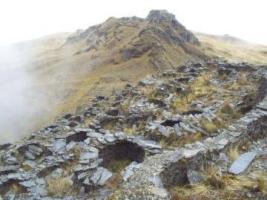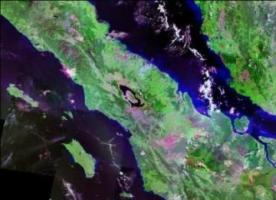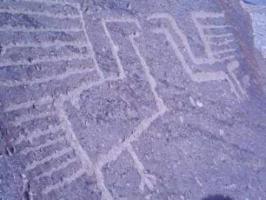Copy Link
Add to Bookmark
Report
Chaos Corner v02 n08

Chaos Corner V02 N08 17Aug92
--------------------------------------------------------
A BOLD NEW PROPOSAL FOR MATCHING HIGH-TECHNOLOGY PEOPLE AND PROFESSIONS
Over the years, the problem of finding the right person for the right
job has consumed thousands of worker-years of research and millions of
dollars of funding. This is particularly true for high-technology
organizations where talent is scarce and expensive. Recently, however,
years of detailed study of the finest minds in the field of
psychoindustrial interpersonnel optimization have resulted in the
development of a simple foolproof test to determine the best match
between personality and profession. Now, at last, people can be
infallibly assigned to the jobs for which they are truly best suited.
CLASSIFICATION GUIDELINES
Mathematicians hunt elephants by going to Africa, throwing out
everything that is not an elephant, and catching one of whatever is
left.
Experienced mathematicians will attempt to prove the existence of at
least one unique elephant before proceeding to step 1 as a subordinate
exercise. Professors of mathematics will prove the existence of at
least one unique elephant and then leave the detection and capture of an
actual elephant as an exercise for their graduate students.
Computer scientists hunt elephants by exercising Algorithm A:
1. Go to Africa.
2. Start at the Cape of Good Hope.
3. Work northward in an orderly manner, traversing the continent
east and west.
4. During each traverse pass,
(a) Catch each animal seen,
(b) Compare each animal caught to a known elephant,
(c) Stop when a match is detected.
Experienced computer programmers modify Algorithm A by placing a known
elephant in Cairo to ensure that the algorithm will terminate.
Assembly language programmers prefer to execute Algorithm A on their
hands and knees.
Engineers hunt elephants by going to Africa, catching gray animals at
random, and stopping when any one of them weighs within + or - 15% of
any previously observed elephant.
Economists don't hunt elephants, but they believe that if elephants are
paid enough, they will hunt themselves.
Statisticians hunt the first animal they see N times and call it an
elephant.
Consultants don't hunt elephants, and many have never hunted anything at
all, but they can be hired by the hour to advise those people who do.
Operations research consultants can also measure the correlation of hat
size and bullet color to the efficiency of elephant-hunting strategies,
if someone else will only identify the elephants.
Politicians don't hunt elephants but they will share the elephants you
catch with the people who voted for them.
Lawyers don't hunt elephants, but they do follow the herds around
arguing about who owns the droppings.
Software lawyers will claim that they own an entire herd based on the
look and feel of one dropping.
Vice presidents of engineering, research and development try hard to
hunt elephants, but their staffs are designed to prevent it. When the
VP does get to hunt elephants, the staff will try to ensure that all
possible elephants are completely prehunted before the VP sees them. If
the VP does see a non-prehunted elephant, the staff will (1) compliment
the VP's keen eyesight, and (2) enlarge itself to prevent any
recurrence.
Senior managers set broad elephant-hunting policy based on the
assumption that elephants are just like field mice, but with deeper
voices.
Quality assurance inspectors ignore the elephants and look for mistakes
the other hunters made when they were packing the jeep.
Salespeople don't hunt elephants but spend their time selling elephants
they haven't caught, for delivery two days before the season opens.
Software salespeople ship the first thing they catch and write up an
invoice for an elephant.
Hardware sales people catch rabbits, paint them gray, and sell them as
desktop elephants.
Ann Halpin (halpinae@dayton.bitnet) contributed the preceding,
originally from Peter Theobald, National Center for Software Technology,
Bombay, India.
-------------------------------------------------------
Static in the Shortwave Listening Article
Dick Crepeau (szyy@cornellf.bitnet) reported problems with reaching the
archive of shortwave listening (SWL) information mentioned in the
previous Chaos Corner. Dr. Chaos points out that I typed the address as
vmsserv@arecibo.aero.edu rather than vmsserv@arecibo.aero.org.
Apologies to Dick and anyone else who tried to reach the archive.
A recent addition is "DX'ers Guide to the Galaxy", now available from
vmsserv@arecibo.aero.org ("send galaxy.txt"). The guide contains
information on DXing (long distance listening) satellites and other
space communications, produced by Radio Sweden.
-------------------------------------------------------
Interested in helping with cloud movies (like the Weather Channel?)
Joe Ahlgren (author of GeoClock, remember?) has been thinking for quite
a while of developing a system where cloud overlays could be played
across GeoClock maps, just as the sunlight overlay is now played. One
of the local "crazies" there (Geoff Chester, who runs the planetarium at
the Air and Space Museum) has built a system in his home to get weather
satellite transmissions automatically and convert then to GIF format.
He posts them on a BBS 4 times per day. Unfortunately, he cannot seem
to get any calibration data so that pixel coordinates can be turned into
lat/long. Joe wonders if there is anyone the Chaos Corner list who
might be interested or helpful in this project?
-------------------------------------------------------
Time Zone Map Available
Joe Ahlgren's time zone expert, Roger Wollstadt, said that the list of
time zone names in the message we sent Joe confirmed his opinion that
there were no standard names. He pointed out that quite a few zones had
English names but no English speaking people! There is a new time zone
paper map, beautifully done, which sites GeoClock as a source. It is
available from MapLink, 25 E Mason St, Santa Barbara CA 93101, 805-965-
4402, for $9.95 plus $5 S&H. (Joe says he doesn't have a piece of the
action, but it is nice to seem his name in print.) Some interesting
things are shown by the map. For example, the Navajo reservation in NE
Arizona celebrates DST (unlike the rest of Arizona), but the completely
surrounded Hopi reservation does not. The DST map, therefore, shows a
square donut in NE Arizona.
-------------------------------------------------------
Got an old version of NCSA Telnet? --- Update it!
Older versions of NCSA Telnet for both the Macintosh and the PC had a
security loophole that you may not be aware of. By default they were
shipped with a configuration file that specified "ftp=yes" meaning that
an FTP server was available in your system any time the program was
active. That FTP server allowed ANYONE on the internet to have
read/write access to all the files on your personal computer. Scared
yet? If not, it may be because you wisely removed that line from the
configuration file -- *wrong* -- "ftp=yes" is the default, so that
option is in effect unless you changed the configuration file to specify
"ftp=no", or unless you set up a password file using the "passfile="
option and the 'telpass' command. Current versions of NCSA Telnet are
available from ftp.ncsa.uiuc.edu in the /PC/Telnet or /Mac/Telnet
directories. The Macintosh version was last updated in July, 1992 and
the PC version was last updated in April, 1992.
------------------------------------------------------
Cleaning Up Empty News Directories
If you happen to get a newsfeed to your Unix system, one problem you
face is that as groups come and go, (particularly in the alt sections)
the directories that were created are left behind to clutter up your
file system. The "last word" on the appropriate command to clean up all
these unused directories is the following Unix 'find' command:
find /usr/spool/news -depth -type d -exec rmdir {} \; >/dev/null 2>&1
This command removes all empty directories, even for active newsgroups,
but that is OK because NNTP (or is it C-News?) will recreate the
directory structure as necessary when articles come in. The only
problem is with the directory 'out.going' (used for posting articles to
the network). The suggested solution is to create a dummy file in the
'out.going' directory so that it doesn't get removed.
-------------------------------------------------------
Converting sound files between various formats
So now you have Windows 3.1 and are having troubles finding the sounds
you want in the .wav format? The popular utility, sox, for converting
between various sound formats is available for PC users, pre-compiled
and located in the /mirrors/msdos/sound directory on wuarchive.wustl.edu
and in the /pc/sound directory on garbo.uwasa.fi (for those of you in
Europe). Look for the file sox4d.zip, and don't forget to use the
'binary' option when transferring it.
Now that you have sox, you can convert the .au format files that you
find on sciences.sdsu.edu in the /sounds directory into .wav files so
that you can associate them with the various Windows events (just like
Mac users have had for years!).
-------------------------------------------------------
Frequently Asked Questions on Audio File Formats (Sound)
All you ever want to know about sound file formats is here in one easy-
to-read 1400 line file. Like most of the FAQ files, this one can be
found on pit-manager.mit.edu. To retrieve it via anonymous FTP, look in
the directory /pub/usenet/alt.binaries.sounds.d, OR for an e-mail
version, send mail to Dr. Chaos at chaos-request@pelican.cit.cornell.edu
asking for a copy of the FAQ on Audio File Formats.
-------------------------------------------------------
Keeping up-to-date on the Time
If you want your Unix workstation to maintain the correct time, you
should use the Network Time Protocol (Version 3 is most current). The
authoritative source for information is on louie.udel.edu. The source
code is in pub/ntp/xntp3.tar.Z. There is a file (clocks.txt) which
lists the best NTP peers to use and also sources for your very own high-
precision radio clocks.
If you just want to know the current time, try the command (this doesn't
work very well from real or simulated 3270-type terminal, but otherwise
it is OK) "telnet india.colorado.edu 13".
-------------------------------------------------------
More Time Information than you'd ever want to Know
The original GMT was the mean time derived from mean solar time (based
on *smoothed* time between successive noons - it's smoothed as the
actual solar time gains and loses about 16 minutes throughout the year
due to the earth's elliptical orbit, etc.). This smoothed time,
however, was not able to correctly deal with the small variations in the
earth's rotation (on the order of thousandths of a second per day).
UT0, based strictly on celestial observations, became the time which
accounts for these variations. UT1 then became the time (based on UT0)
which adjusted for the large scale variations on the earth's rotation.
This time standard, however, was still not precise enough and in 1958,
the US Naval Observatory established A1 using atomic clocks with the
time coordinated with the Greenwich observatory. In 1967, a second was
defined as 9,192,631.770 oscillations of a specific radiation from
cesium 133.
Until the end of 1971 the time was adjusted to match the earth's
rotation when it was about 1/10 second "out of sync." On 1 Jan 1972,
the system was changed and atomic time took over. Enter UTC. When UTC
is out of sync with UT1, a leap second is added (or removed) to UTC.
The last leap second was *added* at 23:59:60 30 June 1992 (note the
second is *60* and not *59*).
So what is GMT? GMT is UT1 (celestial time adjusted for the earth's
rotation). What is Zulu time? So-called Zulu time is UTC which is
based on a set of atomic standards and it may be close to 1 second out
of sync with UT1. Who cares about this difference? Navigators taking
fixes with a sextant need UT1/GMT. A one second error in timing a
sighting will have a 1/4 mile error in the fix.
(The above is abstracted from "Types Of Time" by Bill Brogdon appearing
in Ocean Navigator No. 47) with thanks to Rick Emerson at ssg.com.
-------------------------------------------------------
How do you REALLY write code for BSD Sockets?
In the oldies-but-goodies department (as Dr. Chaos looks through some of
the files that have been around for a while but that people still might
find to be useful) we have a summary of where to locate information on
and programming examples on how to use BSD Sockets for communications.
It was compiled by "Tundra" Tim Daneliuk (tundra@eskimo.chi.il.us). If
you want a copy, send e-mail to chaos-request@pelican.cit.cornell.edu
and ask Dr. Chaos for one.
-------------------------------------------------------
What to do! What to do!
If you say that very often, you just might need the XView To-Do List
manager (XVTDL) that has been recently updated to version 3.1 and, like
much other fine X-Windows free software, is available from THE X11 site,
export.lcs.mit.edu in the contrib directory. For XVTDL, look for the
file xvtdl-3.1.tar.Z.
-------------------------------------------------------
PC Games and supplemental programs
Of course, Dr. Chaos is sure that all you loyal readers recall that the
"standard" collection point for PC games is at ftp.ulowell.edu in the
msdos/Games directories. What you may not know is that a number of the
games (in particular, the Apogee games like Commander Keen and
Wolfenstein 3D have had supplemental programs written for them that do
things like provide maps (or allow you to easily build your own map),
add new levels of play, and describe methods of patching the programs to
get unlimited lives, ammo, etc. Jeff Bryer (umbryer@ccu.umanitoba.ca)
maintains the archive at ccu.umanitoba.ca in the /pub/wolf3d directory.
For a description of what's in the archive, send mail to Dr. Chaos at
chaos-request@pelican.cit.cornell.edu.
-------------------------------------------------------
Weather satellite images for others than North America
Weather satellite images in both the visible and infrared bands are
available in gif format for anonymous FTP from two places that Dr. Chaos
knows about. The files are updated several times a day and may be found
at cumulus.met.ed.ac.uk; look for files /images/gifs/eur.vis.gif or
eur.ir.gif. Other images are available if you replace "eur" with
"norden", "uk", or "world" (this last one shows Europe, Africa, and the
Middle East). Many of these images can also be found at mirror site in
Switzerland, liasun3.epfl.ch in the /pub/weather directory (for your
information, EPFL is the Ecole Polytechnique Federale de Lausanne on the
north side of Lake Geneva).
For weather on the Australian continent, FTP to marlin.jcu.edu.au and
get some of regularly updated GMS-4 images. The images are available
for various Australian states, and the entire country. The images are
in a unusual format, but this is solved by retrieving a public domain
package (ALCHEMY) from many FTP sites. It will handle the conversion
from their format to gif or other formats.
-------------------------------------------------------
Dr. Chaos apologizes for the length of this issue, but the items were
backing up and he was running out of disk space (isn't that always the
case?). Remember, for subscriptions to Chaos Corner, send your request
to chaos-request@pelican.cit.cornell.edu.
Dr. Chaos (I have a Master's Degree





















